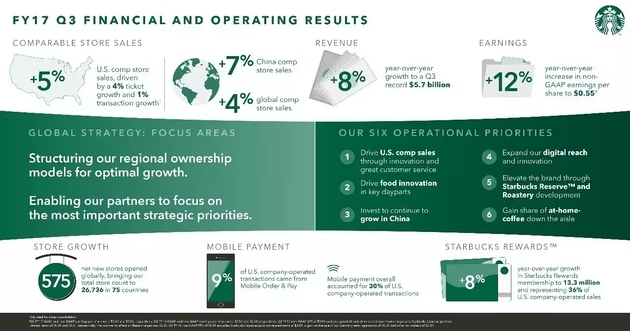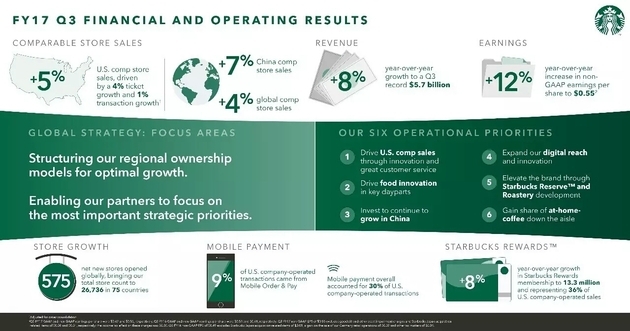Why does Starbucks prefer China? Open another 1.33 stores a day for the next five years.
Follow the caf é (Wechat official account vdailycom) and found that Beautiful Cafe opened a small shop of its own.
All 2800 stores will open to 5000 in 2021.
This is another growth story about the Chinese market. Starbucks spent 1.3 billion dollars to take over the operation of all its stores in mainland China, which means that all Starbucks stores in mainland China will be wholly owned by Starbucks itself, as in the US market.
Starbucks' confidence comes from the high growth and great potential of the Chinese market. For Starbucks, adding weight to the Chinese market is like a gamble, with the rise of the middle class and urbanization as its biggest weight.
All 2800 stores are self-owned.
On the evening of July 27th, Starbucks Coffee announced its largest acquisition agreement to date. Starbucks formally reached an acquisition agreement with its long-term joint venture partners Uni-President Enterprise Co., Ltd. and Uni-President Superstore Co., Ltd. the remaining 50 per cent of Starbucks East China Market Joint Venture (Shanghai Unified Starbucks Coffee Co., Ltd.) will be acquired for about US $1.3 billion in cash.
Through the acquisition, Starbucks will take 100 per cent ownership of about 1300 stores in eastern China, including Jiangsu, Zhejiang and Shanghai. After the completion of the acquisition, Starbucks will achieve full direct management of the mainland market, including all 2800 Starbucks stores in East, South and North China.

It is Starbucks' usual overseas routine to set up a joint venture and then gradually take back control when the time is ripe. This is true in the Japanese market and the same is true in the Chinese market. Since the first store of Chinese mainland was opened in Beijing in January 1999, the Chinese market has rapidly developed into the second largest market after the United States. At the beginning, Starbucks gave the agency in southern China to Hong Kong Mei Xin, North China to Beijing Meida, and East China to Taiwan's reunification. After China allowed wholly foreign-owned enterprises to open stores in 2005, Starbucks bought back shares in Meida, Sanyuan and Meixin in 2006, 2007 and 2011, taking over stores in central, northern and southern China. Now it has taken over the eastern China market through the acquisition of Uni-President's stake.
China is Starbucks' most important overseas market, while East China is the top priority in China, accounting for nearly half of the number of stores in the Chinese market.
Open another 1.33 stores a day for the next five years.
"We are full of confidence in the future development of China. The mainland market has become Starbucks' fastest growing overseas market with the largest number of stores." Starbucks said after announcing the resumption of full direct rights in the mainland market.
The gradual realization of direct marketing in the mainland market is only part of the Starbucks plus-size Chinese market, and Starbucks plans to open stores in the Chinese market at a rapid pace in the future. Starbucks announced an one-year plan in 2016, under which Starbucks will continue to expand at a rate of 500 new stores a year over the next five years, and the number of Starbucks stores in China will expand to 5000 five years later. This year, CEOKevin Johnson, a Starbucks coffee company, once again stressed its goal of growing the number of stores from the current 2800 to 5000 by 2021. It also means that Starbucks will open another 2200 stores in China in four and a half years, with at least 1.33 new stores a day.
Fully regain control of the Chinese market and accelerate the opening of stores in the Chinese market. In Starbucks' strategy, the Chinese market has been raised to an unprecedented height, and the reason behind this is, of course, the high growth and great potential of the Chinese market.
Weakness in the retail and catering industries has sluggish growth in the US, the world's largest market, and Starbucks has stepped up its long-term investment in China, the world's second-largest market.
Starbucks' latest fiscal third-quarter results show that although it rose 8% year-on-year to $5.7 billion from $5.2 billion in the same period last year, net profit fell, with a net profit of $692 million in the third quarter, compared with $754.1 million in the same period last year. Starbucks' global same-store sales rose 4% in the third quarter, compared with 7% in china.
How long can Starbucks' China Miracle last?
Since 2016, Starbucks has repeatedly stressed its plans to open stores in China. At every earnings meeting, the Chinese market is also the focus of investors' concern and attention. Inspired by the vision of 5000 stores, Starbucks loves its China story, and in the eyes of investors, this story of high growth in the Chinese market is enough to support Starbucks' performance and share price all the way up.
Starbucks lost money for three years when it entered Taiwan, but it took only one year and nine months to make a profit in Shanghai, which has the largest number of Starbucks in the world with nearly 600 stores. Starbucks' China story has been full of miracles before. How will Starbucks' China story evolve in the future? How long can Starbucks' China Miracle last?
For Starbucks, the biggest bargaining chip is the rise of China's middle class and a wave of rising consumption. "in the next four years, 300 million people are expected to join the middle class, the total number of the middle class in China will double to more than 600 million, and the emerging middle class will become one of the main drivers of the boutique coffee market." Starbucks explains the reasons for increasing long-term investment in the Chinese market.
Starbucks, which goes against the current, is also at risk, with the biggest uncertainty coming from the reaction of third-and fourth-tier cities. In the context of the increasing saturation of first-and second-tier cities, whether Starbucks' rapid expansion in third-and fourth-tier cities can be steadily promoted has become the biggest mystery.
In addition, Starbucks is not the only coffee brand expanding its stores in the Chinese market. COSTA, Pacific Coffee (3.970,-0.01,0.25%) Coffee and other European and American, diffuse Coffee, ZOO and other Korean, as well as local boutique cafes are diverting Starbucks passenger flow. In particular, with the rise of a new generation of tea chains in China, these new Chinese tea shops with capital have become Starbucks' biggest competitor in the Chinese market.
Important Notice :
前街咖啡 FrontStreet Coffee has moved to new addredd:
FrontStreet Coffee Address: 315,Donghua East Road,GuangZhou
Tel:020 38364473
- Prev

How hard is it to sell a cup of tea? Starbucks closes all its 379 Teavana tea stores
Tea or coffee (Tea or Coffee)? This is the most common question asked by Westerners when entertaining guests. When coffee entered the Chinese market on a large scale, many beverage stores in China also began to offer consumers a choice of tea and coffee. Starbucks, the world's largest coffee chain, is naturally reluctant to let go of the tea business. However, only recently, Starbucks finally realized that selling tea and
- Next

After Sears, Starbucks tea shop also closed! Close all its Teavana tea stores
Following Kaiping (Wechat official account vdailycom) found that Beautiful Cafe opened a small shop of its own, with 2800 stores all operating itself to 5000 in 2021. This is another growth story about the Chinese market. Starbucks spent 1.3 billion US dollars to take over the operation rights of all Starbucks stores in mainland China, which means that all Starbucks stores in mainland China will be owned by Starbucks.
Related
- Why does hot American coffee taste bitter? Difference in proportional concentration between hot American and ice American
- Is espresso stored overnight in the refrigerator harmful to your body? Is frozen coffee better than freshly ground coffee?
- What parameters and proportions of water temperature should be used to grind and brew fresh coffee beans? Why can't I drink freshly roasted coffee right away?
- Customers have "changed" Manner's new products! Shop assistant: Please don't mess around!
- Remove sockets in customer areas at Starbucks stores?! Netizen: I won't go if I really tear it down
- What is the difference between the taste steps of sun-dried coffee and washed coffee? Why is sun-cured coffee sweeter and washed coffee sour?
- The recipe for salty grapefruit dirty is revealed! Coffee Festival salty grapefruit dirty coffee making materials parameters ratio milk share!
- How about the flavor of Sunlight 74158 at Sidamo Banshaha Mathieu Processing Factory in Ethiopia? 74158 Share the proportion of coffee brewing parameters!
- What effect does Italian American coffee with filter paper have? Will coffee taste better if it is put on filter paper at the bottom of the powder bowl?
- What is the color difference in coffee beans? What are the characteristics of honey processed coffee beans? Why are the anaerobically treated coffee beans uneven in color?

